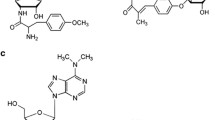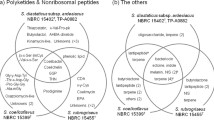Abstract
Prodigiosin and undecylprodigiosin are tripyrrolic red pigmented antibiotics produced by certain bacteria. Many strains of Serratia and certain other Gammaproteobacteria produce prodigiosin and undecylprodigiosin is produced by certain strains of Streptomyces. This is a multistage process which involves the synthesis of a bipyrrolic compound from L-proline and its subsequent condensation with a mono pyrrole synthesized from 2-octenal in the case of prodigiosin and malonyl-CoA in the case of undecylprodigiosin respectively. We have carried out sequence analysis of the genes involved in the pathway and identified the distribution of the prodigiosin producing genes amongst the various bacteria which have been fully sequenced. The presence of the operon was clearly seen in certain clustered branches suggesting inheritance from a common ancestor. This was further confirmed by the absence of traits observed in horizontally acquired genes like, GC content variation, codon bias or the presence of mobile elements. Multiple sequence alignment of the promoter of the prodigiosin operon in seven fully sequenced Serratia marcescens strains showed excellent homology. Putative regulatory elements in this region were identified by sequence analysis studies and many of them have been found to influence pigment production. The undecylprodigiosin gene cluster on the other hand, shows homology to other gene clusters involved in the production of other pyrrole-containing antibiotics of the genus Streptomyces. This coupled with the presence of ORFs with three different promoters could indicate lateral gene transfer. Hence the evolution of undecylprodigiosin operon could be an example of convergent evolution.





Similar content being viewed by others
References
Simon M, Scheuner C, Meier-Kolthoff JP et al (2017) Phylogenomics of Rhodobacteraceae reveals evolutionary adaptation to marine and non-marine habitats. ISME J 11:1483–1499. https://doi.org/10.1038/ismej.2016.198
Fani R, Brilli M, Liò P (2005) The origin and evolution of operons: the piecewise building of the proteobacterial histidine operon. J Mol Evol 60:378–390. https://doi.org/10.1007/s00239-004-0198-1
Price MN, Arkin AP (2005) Operon formation is driven by co-regulation and not by horizontal gene transfer. Genome Res 15:809–819. https://doi.org/10.1101/gr.3368805
Corbell N, Loper JE (1995) A global regulator of secondary metabolite production in Pseudomonas fluorescens Pf-5. J Bacteriol 177:6230–6236
Mao D, Bushin LB, Moon K et al (2017) Discovery of scmR as a global regulator of secondary metabolism and virulence in Burkholderia thailandensis E264. Proc Natl Acad Sci 114:E2920–E2928. https://doi.org/10.1073/pnas.1619529114
García-Estrada C, Domínguez-Santos R, Kosalková K, Martín J-F (2018) Transcription factors controlling primary and secondary metabolism in filamentous fungi: the β-Lactam paradigm. Ferment 4:47. https://doi.org/10.3390/fermentation4020047
Yan Q, Lopes LD, Shaffer BT et al (2018) Secondary metabolism and interspecific competition affect accumulation of spontaneous mutants in the GacS-GacA regulatory system in Pseudomonas protegens. MBio 9:e01845–e01817. https://doi.org/10.1128/mBio.01845-17
Mahlen SD (2011) Serratia infections: from military experiments to current practice. Clin Microbiol Rev 24:755–791. https://doi.org/10.1128/CMR.00017-11
Williamson NR, Fineran PC, Leeper FJ, Salmond GPC (2006) The biosynthesis and regulation of bacterial prodiginines. Nat Rev Microbiol 4:887–899. https://doi.org/10.1038/nrmicro1531
Kulandaisamy Venil C, Lakshmanaperumalsamy P (2009) An insightful overview on microbial pigment. Prodigiosin EJBio 5(3):49–61
Cerdeño AM, Bibb MJ, Challis GL (2001) Analysis of the prodiginine biosynthesis gene cluster of Streptomyces coelicolor A3(2): new mechanisms for chain initiation and termination in modular multienzymes. Chem Biol 8:817–829. https://doi.org/10.1016/S1074-5521(01)00054-0
Kawasaki T, Sakurai F, Nagatsuka S, Hayakawa Y (2009) Prodigiosin biosynthesis gene cluster in the roseophilin producer Streptomyces griseoviridis. J Antibiot 62:271–276. https://doi.org/10.1038/ja.2009.27
Williamson NR, Simonsen HT, Ahmed RAA et al (2005) Biosynthesis of the red antibiotic, prodigiosin, in Serratia: identification of a novel 2-methyl-3-n-amyl-pyrroie (MAP) assembly pathway, definition of the terminal condensing enzyme, and implications for undecylprodigiosin biosynthesis in Streptomyces. Mol Microbiol 56:971–989. https://doi.org/10.1111/j.1365-2958.2005.04602.x
Li P, Kwok AHY, Jiang J et al (2015) Comparative genome analyses of Serratia marcescens FS14 reveals its high antagonistic potential. PLoS ONE 10(4):e0123061. https://doi.org/10.1371/journal.pone.0123061
Su C, Xiang Z, Liu Y et al (2016) Analysis of the genomic sequences and metabolites of Serratia surfactantfaciens sp. nov. YD25 T that simultaneously produces prodigiosin and serrawettin W2. BMC Genom 1–19. https://doi.org/10.1186/s12864-016-3171-7
Kim D, Lee JS, Park YK et al (2007) Biosynthesis of antibiotic prodiginines in the marine bacterium Hahella chejuensis KCTC 2396. 102:937–944. https://doi.org/10.1111/j.1365-2672.2006.03172.x
Gummadidala PM, Holder ME, O’Brien JL et al (2017) Complete genome sequence of Vibrio gazogenes ATCC 43942. Genome Announc 5:e00733–e00717. https://doi.org/10.1128/genomeA.00733-17
Fehér D, Barlow RS, Lorenzo PS, Hemscheidt TK (2008) A 2-substituted prodiginine, 2-(p-hydroxybenzyl)prodigiosin, from Pseudoalteromonas rubra. J Nat Prod 71:1970–1972. https://doi.org/10.1021/np800493p
Schloss PD, Allen HK, Klimowicz AK et al (2010) Psychrotrophic strain of Janthinobacterium lividum from a Cold Alaskan Soil Produces Prodigiosin. DNA Cell Biol 29:533–541. https://doi.org/10.1089/dna.2010.1020
Gerber NN (1969) Prodigiosin-like pigments from Actinomadura (Nocardia) pelletieri and Actinomadura madurae. Appl Microbiol 18:1–3. https://doi.org/10.7164/antibiotics.24.636
Lapenda Lins JC, Maciel CCS, Xavier HS et al (2014) Production and toxicological evaluation of prodigiosin from Serratia marcescens UCP/WFCC1549 on Mannitol Solid Medium. Int J Appl Res Nat Prod 7:32–38
Lapenda JC, Silva PA, Vicalvi MC et al (2014) Antimicrobial activity of prodigiosin isolated from Serratia marcescens UFPEDA 398. World J Microbiol Biotechnol 31:399–406. https://doi.org/10.1007/s11274-014-1793-y
Darshan N, Manonmani HK (2015) Prodigiosin and its potential applications. J Food Sci Technol 52:5393–5407. https://doi.org/10.1007/s13197-015-1740-4
Haddix PL, Jones S, Patel P et al (2008) Kinetic analysis of growth rate, ATP, and pigmentation suggests an energy-spilling function for the pigment prodigiosin of Serratia marcescens. J Bacteriol 190:7453–7463. https://doi.org/10.1128/JB.00909-08
Medema MH, Takano E, Breitling R (2013) Detecting sequence homology at the gene cluster level with multigeneblast. Mol Biol Evol 30:1218–1223. https://doi.org/10.1093/molbev/mst025
Zuo G, Hao B (2015) CVTree3 web server for whole-genome-based and alignment-free prokaryotic phylogeny and taxonomy. Genom Proteom Bioinform 13:321–331. https://doi.org/10.1016/j.gpb.2015.08.004
Letunic I, Bork P (2016) Interactive tree of life (iTOL) v3: an online tool for the display and annotation of phylogenetic and other trees. Nucleic Acids Res 44:W242–W245. https://doi.org/10.1093/nar/gkw290
Darling ACE, Mau B, Blattner FR, Perna NT (2004) Mauve: multiple alignment of conserved genomic sequence with rearrangements mauve : multiple alignment of conserved genomic sequence with rearrangements. Genome Res 14:1394–1403. https://doi.org/10.1101/gr.2289704
Kumar S, Stecher G, Li M et al (2018) MEGA X: molecular evolutionary genetics analysis across computing platforms. Mol Biol Evol 35:1547–1549. https://doi.org/10.1093/molbev/msy096
Vernot B, Stolzer M, Goldman A, Durand D (2008) Reconciliation with non-binary species trees. J Comput Biol 15:981–1006. https://doi.org/10.1089/cmb.2008.0092
Durand D, Halldórsson BV, Vernot B (2006) A Hybrid Micro–macroevolutionary approach to gene tree reconstruction. J Comput Biol 13:320–335. https://doi.org/10.1089/cmb.2006.13.320
Stolzer M, Lai H, Xu M et al (2012) Inferring duplications, losses, transfers and incomplete lineage sorting with nonbinary species trees. Bioinformatics 28:409–415. https://doi.org/10.1093/bioinformatics/bts386
Darby CA, Stolzer M, Ropp PJ et al (2016) Xenolog classification. Bioinformatics 33:btw686. https://doi.org/10.1093/bioinformatics/btw686
Bertelli C, Laird MR, Williams KP et al (2017) IslandViewer 4: expanded prediction of genomic islands for larger-scale datasets. Nucleic Acids Res 45:W30–W35. https://doi.org/10.1093/nar/gkx343
Solovyev V, Salamov A (2011) Automatic annotation of microbial genomes and metagenomic sequences vector. In: RW Li (ed) Metagenomics and its applications in agriculture, biomedicine and environmental studies. Nova Science Publishers, Hauppauge pp 61–78
Poirot O, O’Toole E, Notredame C (2003) Tcoffee@igs: a web server for computing, evaluating and combining multiple sequence alignments. Nucleic Acids Res 31:3503–3506. https://doi.org/10.1093/nar/gkg522
Münch R, Hiller K, Grote A et al (2005) Virtual footprint and PRODORIC: an integrative framework for regulon prediction in prokaryotes. Bioinformatics 21:4187–4189. https://doi.org/10.1093/bioinformatics/bti635
Sahni RD, Amalanathan R, Devanga Ragupathi NK et al (2016) Complete genome sequence of Serratia marcescens U36365, a green pigment–producing strain isolated from a patient with urinary tract infection. Genome Announc 4:e00837–e00816. https://doi.org/10.1128/genomeA.00837-16
Thomas T, Evans FF, Schleheck D et al (2008) Analysis of the Pseudoalteromonas tunicata genome reveals properties of a surface-associated life style in the marine environment. PLoS ONE 3:1–11. https://doi.org/10.1371/journal.pone.0003252
Nowak-thompson B, Chaney N, Wing JS et al (1999) Characterization of the pyoluteorin biosynthetic gene cluster of characterization of the pyoluteorin biosynthetic gene cluster of Pseudomonas fluorescens Pf-5. J Bacteriol 181:2166–2174
Coulhurst SJ, Williamson NR, Harris AKP et al (2006) Metabolic and regulatory engineering of Serratia marcescens: mimicking phage-mediated horizontal acquisition of antibiotic biosynthesis and quorum-sensing capacities. Microbiology 152:1899–1911. https://doi.org/10.1099/mic.0.28803-0
Horng YT, Deng SC, Daykin M et al (2002) The LuxR family protein SpnR functions as a negative regulator of N-acylhomoserine lactone-dependent quorum sensing in Serratia marcescens. Mol Microbiol 45:1655–1671. https://doi.org/10.1046/j.1365-2958.2002.03117.x
Wu Q, Liang J, Lin S et al (2011) Characterization of the biosynthesis gene cluster for the pyrrole polyether antibiotic calcimycin (A23187) in Streptomyces chartreusis NRRL 3882. Antimicrob Agents Chemother 55:974–982. https://doi.org/10.1128/AAC.01130-10
Li C, Roege KE, Kelly WL (2009) Analysis of the indanomycin biosynthetic gene cluster from Streptomyces antibioticus NRRL 8167. ChemBioChem 10:1064–1072. https://doi.org/10.1002/cbic.200800822
Salem SM, Kancharla P, Florova G et al (2014) Elucidation of final steps of the marineosins biosynthetic pathway through identification and characterization of the corresponding gene cluster. J Am Chem Soc 136:4565–4574. https://doi.org/10.1021/ja411544w
Moreno-Letelier A, Olmedo G, Eguiarte LE et al (2011) Parallel evolution and horizontal gene transfer of the pst operon in Firmicutes from oligotrophic environments. Int J Evol Biol 2011:1–10. https://doi.org/10.4061/2011/781642
Gristwood T, Fineran PC, Everson L et al (2009) The PhoBR two-component system regulates antibiotic biosynthesis in Serratia in response to phosphate. BMC Microbiol 9:112. https://doi.org/10.1186/1471-2180-9-112
Coulthurst SJ, Kurz CL, Salmond GPC (2004) luxS mutants of Serratia defective in autoinducer-2-dependent “quorum sensing” show strain-dependent impacts on virulence and production of carbapenem and prodigiosin. Microbiology 150:1901–1910. https://doi.org/10.1099/mic.0.26946-0
Fineran PC, Everson L, Slater H, Salmond GPC (2005) A GntR family transcriptional regulator (PigT) controls gluconate-mediated repression and defines a new, independent pathway for regulation of the tripyrrole antibiotic, prodigiosin, in Serratia. Microbiology 151:3833–3845. https://doi.org/10.1099/mic.0.28251-0
Ishihama A (2010) Prokaryotic genome regulation: multifactor promoters, multitarget regulators and hierarchic networks. FEMS Microbiol Rev 34:628–645. https://doi.org/10.1111/j.1574-6976.2010.00227.x
Shanks RMQ, Lahr RM, Stella NA et al (2013) A Serratia marcescens PigP homolog controls prodigiosin biosynthesis, swarming motility and hemolysis and is regulated by cAMP-CRP and HexS. PLoS ONE 8:e57634. https://doi.org/10.1371/journal.pone.0057634
Williamson NR, Simonsen HT, Harris AKP et al (2006) Disruption of the copper efflux pump (CopA) of Serratia marcescens ATCC 274 pleiotropically affects copper sensitivity and production of the tripyrrole secondary metabolite, prodigiosin. J Ind Microbiol Biotechnol 33:151–158. https://doi.org/10.1007/s10295-005-0040-9
Acknowledgements
This work was supported by a Grant from Department of Biotechnology, Government of India, (BT/PR5106/BRB/10/1073/2012). We also thank the Department of Science and Technology, Government of India for their funding. Aarti Ravindran thanks Council of Scientific and Industrial Research, Government of India for her Fellowship (CSIR-NET). The authors are grateful to Dr. Sharmila Anishetty for her valuable insights and guidance during this work.
Author information
Authors and Affiliations
Corresponding author
Ethics declarations
Conflict of interest
The authors declare that they have no conflict of interest.
Additional information
Publisher’s Note
Springer Nature remains neutral with regard to jurisdictional claims in published maps and institutional affiliations.
Electronic supplementary material
Below is the link to the electronic supplementary material.
Rights and permissions
About this article
Cite this article
Ravindran, A., Sunderrajan, S. & Pennathur, G. Phylogenetic Studies on the Prodigiosin Biosynthetic Operon. Curr Microbiol 76, 597–606 (2019). https://doi.org/10.1007/s00284-019-01665-0
Received:
Accepted:
Published:
Issue Date:
DOI: https://doi.org/10.1007/s00284-019-01665-0




